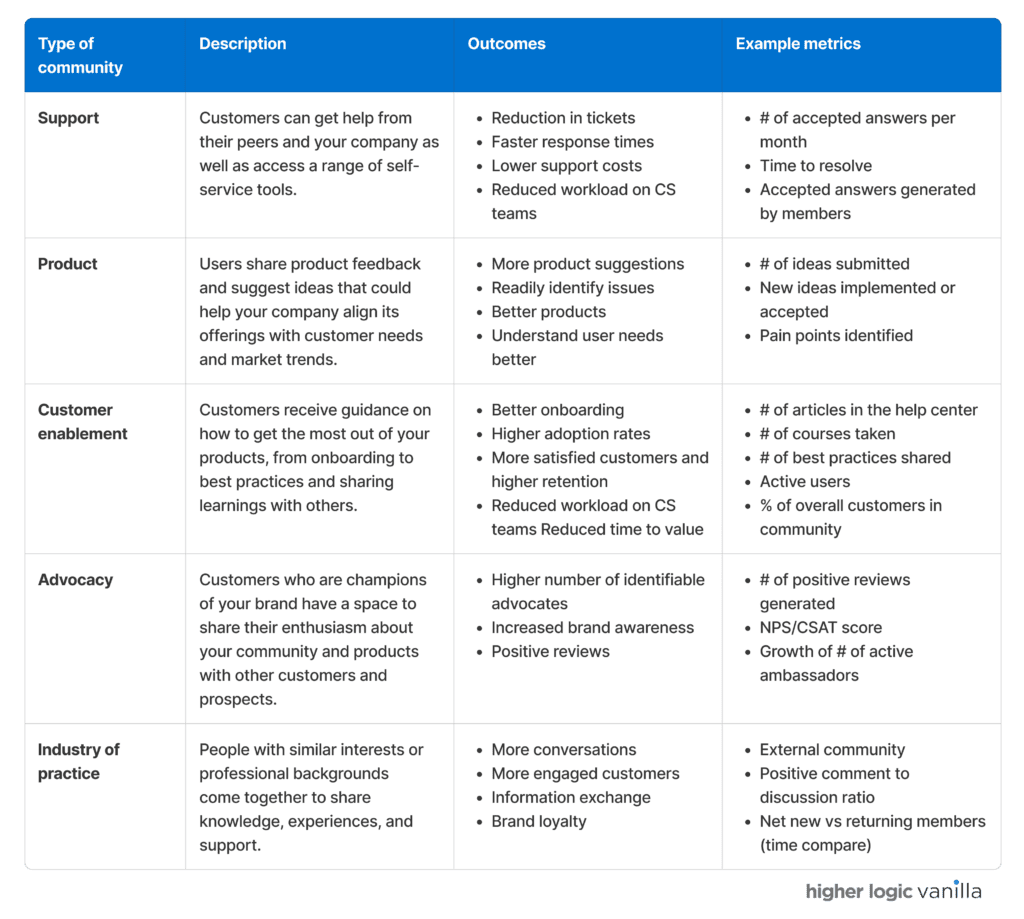
How to Build an Online Community: A 3-Step Framework
Are you getting ready to build or relaunch an online community? Much of your success depends on how well you prepare. In this article, we’ll share a three-step framework that you can use to establish a strong foundation for your online community.
By planning ahead with this framework, you’re more likely to be aligned with your stakeholders, catch any potential issues early, and get users participating quickly.
1. Define the goals of your online community.
As with any project, if you don’t have clear goals, it’s easy to get off track. That’s why we start with defining the goals for your community at each level: organizationally, departmentally, and for your end-users. What does each group want to get out of an online community?
To create goals for your online community, start by thinking about what you’re trying to achieve at this point in your community journey. These questions can help:
- What community activities will benefit your internal teams? Talk to as many people as you can and figure out what activities will benefit them.
- What community ROI does leadership care about? Consider your company’s long-term objectives and immediate priorities, including financial targets, market expansion plans, or efficiency improvements, and how your community can support these. Additionally, linking your pitch to broader market trends that align with your community goals can be highly persuasive. But avoid forcing this connection.
- What community activities will most benefit your customers? Identify the gaps in your customer journey and think creatively about how your community can fill them in.
Once you’ve gone through these questions, you might find that groups have different and even conflicting priorities for the community. In this case, you might need to do some additional brainstorming, prioritizing, and consensus-building to think about how you can align these goals and build a community that supports every need.
As your community grows organically, your goals might change. We’ll cover this more later when we talk about community maturity, but first, let’s look at some examples of goals you could have:
- Increase customer success efficiency
- Reduce ticket submissions
- Improve gross retention
- Increase revenue opportunities
- Increase brand awareness
- Gather more product feedback
- Identify advocates more easily
- Improve product adoption
Tip: Don’t try to pursue every goal you could aim for at once. It’s better to do one or two things well than to do ten things mediocrely.
Once you’ve determined your community goal(s), you should let that inform the type of community you choose to create.
2. Select an online community type that aligns with your goals.
Next, choose the type of community that best supports your goals.
Here are the most common community use cases:

The use cases of a community often correlate with its maturity level. Many online communities initially focus on support, enablement, or product-related discussions. As they mature, they tend to expand to encompass more complex functions such as advocacy and specialized interest groups.
However, starting a community with these complex functions is generally not recommended, as they can be demanding and may not offer immediate rewards to new members. The decision to expand the scope of a community should be a strategic one that you make based on the community’s readiness and user base strength.
Once you’ve chosen a community type, it’s time to launch your online community and get it engaged.
3. Launch and activate your community.
After you’ve established your goals and chosen your community type, your next step is to get customers signed up and interacting in the online community. To do this, create a plan to engage these members, encourage their participation, and bring them back to the community. As your community matures, you can nurture active users into advocates, who can help you share thought leadership and introduce new people to your community and company.
Acquire new users.
To form a community acquisition strategy, start by thinking about what’s in it for your users. Create clear reasons to join that tap into what they’re looking for. For example, if it’s a support community and you know they want to solve their problems quickly, make one of your calls to action (CTA) “get fast answers.” Try these ideas to attract new users:
- Create CTAs on all guest-facing pages of the community.
- Work with marketing and sales leadership to mention the online community in their prospect-facing resources.
- Connect with your implementation team and customer success managers to introduce the community during onboarding.
- Bake the idea of sending new customers to the community into any processes or playbooks your teams already use.
- Integrate your community with other sites in your tech stack, like learning management or ticketing systems.
- If your marketing and customer success teams already send regular emails or newsletters, provide them with links to great community content they could incorporate.
- Identify which customers are not yet in the community, and invite them to join. Clearly define the value, the community’s purpose, and what’s in it for them.
Engage existing users.
Once you’ve launched, think about what will keep users coming back. One helpful exercise can be to brainstorm activities to engage specific personas.
Try these online community engagement tactics:
- Send content to users via weekly or monthly newsletters or an email digest to inspire them to return.
- Send a welcome email. Include value statements and the first steps they can take in the community.
- Send “we miss you!” messages with automation (or on a one-on-one basis if you have that bandwidth).
- Host networking events to help customers connect with your community manager and with each other. This is one of the most important things you can do to instill a sense of community.
- Gather customer feedback within the community.
- Create a comunity content calendar for community engagement posts and activities. Make it easy to fill by theming days of the week, like instituting “Tip Tuesday” where you share a tip about using the community software better. This helps you stay consistent and build a following with users.
To assess the potential of an engagement tactic to generate community activity, ask yourself: Is this going to encourage customers to continue the conversation with each other and with us? Sometimes, you may have to test it to find out.
Tip: Don’t exhaust yourself or your resources during launch. It’s tempting to want to do everything at launch or relaunch, but hold back some of your engagement ideas to sustain that excitement. Keep excess ideas in your content calendar to make sure you’ve got something great every month, every quarter, and every year. This will help keep your community successful for the long-term.
The online community platform you choose may have built-in tools to make your engagement job easier. For example, Higher Logic Vanilla offers tools like leaderboards, polling, points and badges.
Create advocates.
Your advocates will generally emerge over time, but there are a few things you can do to develop a community environment that fosters advocacy.
Here’s an important thing to know about advocates: Users who share content in the community are taking the first steps towards advocacy, so don’t underestimate the value of these creators.
Consider rewarding creators in ways that are meaningful to them. This might mean shout-outs, tangible rewards, or special recognition. Don’t hesitate to ask these individuals what they’d like to see more of in the community. You can also engage them by asking for their help with specific questions they have expertise in or by inviting them to speak at a community event.
In addition, you can try implementing gamification tactics, such as ranks or leaderboards, to motivate customers to get involved, whether they’re participating in promotional activities, product feedback sessions, or community discussions.
The more you can encourage customers to talk to each other and answer each other’s questions, the more you can help them develop the confidence they need to become an advocate in the future.
5 online community building questions to ask yourself.
This framework is simple, but it can be overwhelming when you start getting into the details. Simplify the process by asking yourself these questions:
- Goals. What are your organizational, departmental, and end-users’ goals? How can those be best aligned?
- Type. What community type aligns best with your goals? If you already have a community, what do you need to do to bridge any gaps between its current state and your goals?
- Maturity. If you already have a community, how mature is it? Are you ready to take on another facet of community?
- Content. How can you appeal to a variety of personas? How can you make sure that consumers, contributors, and creators all have a place in the community and are actively receiving value from the community?
- Centrality. How can you make the community the hub of your customer journey? How can you make going to the community a knee-jerk reaction for users?
Remember, by forming a well thought-out plan, you’ve already taken a huge step forward on your journey to community success.
Looking for more resources to help you along in your online community journey? Grab our Customer Community Playbook.


